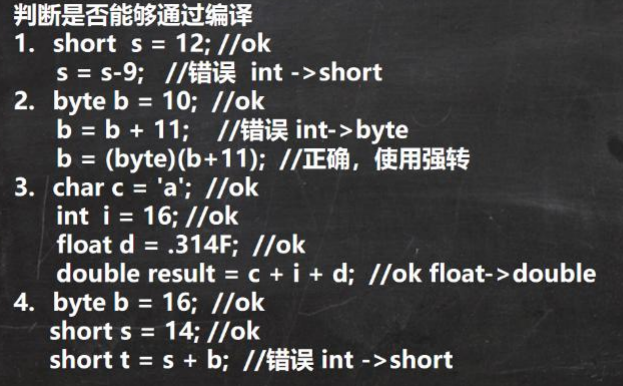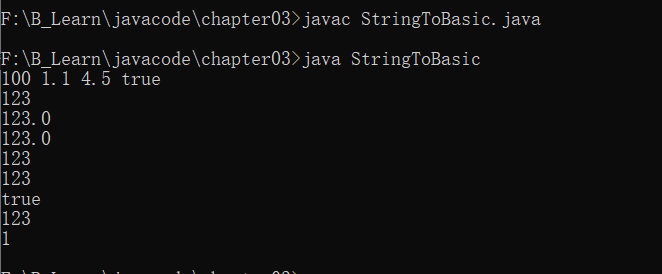- 自动类型转换
当java程序在进行赋值或运算时,精度小的类型自动转换为精度大的数据类型,这就是自动类型转换。
数据类型按精度(容量)大小排序为

public class AutoConvert{
public static void main(String[] args){
//演示自动类型转换
int a = 'a';//对 char -> int
double b = 80;//对 int -> double
System.out.println(a);
System.out.println(b);
}
}

- 自动类型转换注意和细节
- 有很多类型的数据混合运算时,系统自动将所有数据转换成容量最大的那种数据类型,然后再进行计算。
- 当我们把精度(容量)大的数据类型赋值给精度(容量)小的数据类型时,就会报错,反之就会进行自动类型转换。
- (byte,short)和char之间不会相互自动转换。
- byte,short,char 他们三者可以计算,在计算时首先转换为int类型。
- boolean 不参与转换。
- 自动提升原则:表达式结果的类型自动提升为操作数中最大的类型。
//自动类型转换细节
public class AutoConvertDetail{
public static void main(String[] args){
// 有很多类型的数据混合运算时,系统自动将所有数据转换成容量最大的那种数据类型,然后再进行计算。
int n1 = 10;
// float d1 = n1 + 1.1;//错误, n1 + double => 结果类型是double
double d1 = n1 + 1.1;//正确
float d2 = n1 + 1.1F;//正确
//当我们把精度(容量)大 的数据类型赋值给精度(容量)小 的数据类型时,就会报错,反之就会进行自动类型转换。
//int n2 = 1.1;//错误 double -> int
//细节 3: (byte, short) 和 char 之间不会相互自动转换
//当把具体数赋给 byte 时,(1)先判断该数是否在 byte 范围内,如果是就可以
byte b1 = 10; //对 , -128-127
// int n2 = 1; //n2 是 int
// byte b2 = n2; //错误,原因: 如果是变量赋值,判断类型
// char c1 = b1; //错误, 原因 byte 不能自动转成 char
// byte,short,char 他们三者可以计算,在计算时首先转换为 int 类型
byte b2 = 1;
byte b3 = 2;
short s1 = 1;
//short s2 = b2 + s1;//错, b2 + s1 => int
int s2 = b2 + s1;//对, b2 + s1 => int
//byte b4 = b2 + b3; //错误: b2 + b3 => int
//boolean 不参与转换
boolean pass = true;
//int num100 = pass;// boolean 不参与类型的自动转换
//自动提升原则: 表达式结果的类型自动提升为 操作数中最大的类型
byte b4 = 1;
short s3 = 100;
int num200 = 1;
float num300 = 1.1F;
double num500 = b4 + s3 + num200 + num300; //float -> double
}
}
- 强制类型转换
自动类型转换的逆过程,将容量大的数据类型转换为容量小的数据类型。使用时要加上强制转换符(),但可能造成精度降低或溢出,要格外注意。
public class ForceConvert{
public static void main(String[] args){
//演示强制转换类型
int n1 = (int)1.9;
System.out.println("n1 = " + n1);//结果:1,造成精度损失
int n2 = 2000;
byte b1 = (byte)n2;
System.out.println("b1 = " + b1);//结果:-48,造成数据溢出
}
}

- 强制类型转换细节说明
- 当进行数据的大小 从 大 -> 小 ,就需要使用到强制转换。
- 强转符号只针对于最近的操作数有效,往往会使用小括号提升优先级。
- char类型可以保存int的常量值,但不能保存int的变量值,需要强转。
- byte和short类型在进行运算时,当做int类型处理。
public class ForceConvertDetail{
public static void main(String[] args) {
//强转符号只针对于最近的操作数有效,往往会使用小括号提升优先级
////int x = (int)10*3.5+6*1.5;//编译错误: double -> int
int x = (int)(10*3.5+6*1.5);// (int)44.0 -> 44
System.out.println(x);//44
char c1 = 100; //ok
int m = 100; //ok
//char c2 = m; //错误
char c3 = (char)m; //ok
System.out.println(c3);//100 对应的字符, d 字符
}
}


- 基本数据类型和String类型的转换
- 基本类型转String类型:将基本类型的值+""即可。
- String类型转基本数据类型:通过基本类型的包装类调用parseXXX方法即可。
public class StringToBasic{
public static void main(String[] args) {
//基本数据类型 -> String
int n1 = 100;
float f1 = 1.1F;
double d1 = 4.5;
boolean b1 = true;
String s1 = n1 + "";
String s2 = f1 + "";
String s3 = d1 + "";
String s4 = b1 + "";
System.out.println(s1 + " " + s2 + " " + s3 + " " + s4);
//String->对应的基本数据类型
String s5 = "123";
int num1 = Integer.parseInt(s5);
float num2 = Float.parseFloat(s5);
double num3 = Double.parseDouble(s5);
long num4 = Long.parseLong(s5);
byte num5 = Byte.parseByte(s5);
boolean num6 = Boolean.parseBoolean("true");
short num7 = Short.parseShort(s5);
System.out.println(num1);//123
System.out.println(num2);//123.0
System.out.println(num3);//123.0
System.out.println(num4);//123
System.out.println(num5);//123
System.out.println(num6);//true
System.out.println(num7);//123
//怎么把字符串转成字符 char -> 含义是指 把字符串的第一个字符得到
//解读 s5.charAt(0) 得到 s5 字符串的第一个字符 '1'
System.out.println(s5.charAt(0));
}
}

- 注意事项
- 在将 String 类型转成 基本数据类型时,要确保String类型能够转成有效的数据 ,比如 我们可以把 "123" , 转成一 个整数,但是不能把 "hello" 转成一个整数。
- 如果格式不正确,就会抛出异常,程序就会终止。
public class StringToBasicDetail{
public static void main(String[] args) {
String str = "hello";
//转成int
int n1 = Integer.parseInt(str);
System.out.println(n1);
}
}







